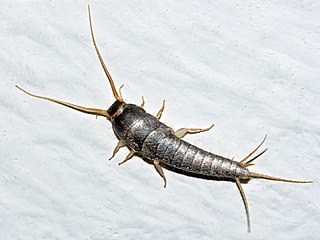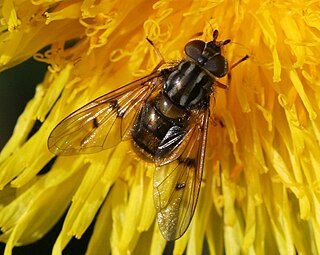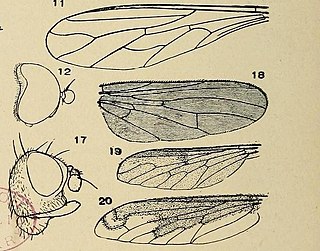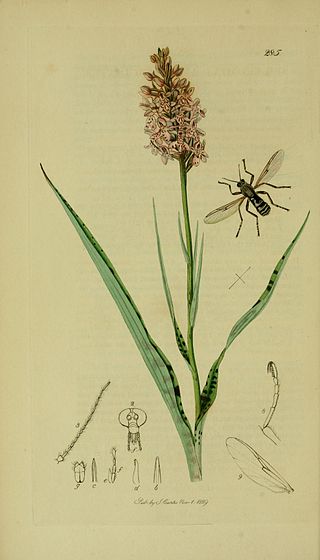
The cicadas are a superfamily, the Cicadoidea, of insects in the order Hemiptera. They are in the suborder Auchenorrhyncha, along with smaller jumping bugs such as leafhoppers and froghoppers. The superfamily is divided into two families, the Tettigarctidae, with two species in Australia, and the Cicadidae, with more than 3,000 species described from around the world; many species remain undescribed. Nearly all of cicada species are annual cicadas with the exception of the few North American periodical cicada species, genus Magicicada, which in a given region emerge en masse every 13 or 17 years.

Stag beetles comprise the family Lucanidae. It has about 1,200 species of beetles in four subfamilies. Some species grow to over 12 centimetres, but most to about 5 cm (2 in).

Homalopsis buccata is a species of mildly venomous snake in the Homalopsidae family found in tropical areas of Southeast Asia.

The silverfish is a species of small, primitive, wingless insect in the order Zygentoma. Its common name derives from the insect's silvery light grey colour, combined with the fish-like appearance of its movements. The scientific name indicates that the silverfish's diet consists of carbohydrates such as sugar or starches. While the common name silverfish is used throughout the global literature to refer to various species of Zygentoma, the Entomological Society of America restricts use of the term solely for Lepisma saccharinum.

Campiglossa is a genus of fruit flies in the family Tephritidae. There are at least 190 described species in Campiglossa.

The variegated spring beegrabber is a species of fly from the genus Myopa in the family Conopidae. Their larvae are endoparasites of bumble bees of the genus Bombus. It is common throughout much of Europe.

Ferdinandea is a genus of syrphid flies or hoverflies in the family Syrphidae. There are about 16 described species in Ferdinandea.

Silverjaw minnows are part of the family Cyprinidae, which includes carps and minnows. With over 300 known species, there are more species of minnows native to North America's fresh waters than any other fish. Minnows can be hard to distinguish because many look alike. All minnows have one dorsal fin, ventral fins near the anus, a lateral line system, and smooth, round cycloid scales. Their jaws lack teeth, but they have one to three rows of pharyngeal teeth to grind food. Defining physical characteristics such as the number and type of fin rays, type of scales, and pattern of pharyngeal teeth are used to distinguish minnows.

Entomologia Carniolica exhibens insecta Carnioliae indigena et distributa in ordines, genera, species, varietates is a taxonomic work by Giovanni Antonio Scopoli, published in Vienna in 1763. As well as describing hundreds of new species, Entomologia Carniolica contained observations on the species' biology, including the first published account of queen bees mating outside the hive.

Ferdinandea cuprea is a European species of hoverfly notable for its brassy abdomen. The larvae have been found in sap from trunk damage on oak and ash.
BugGuide is a website and online community of naturalists, both amateur and professional, who share observations of arthropods such as insects, spiders, and other related creatures. The website consists of informational guide pages and many thousands of photographs of arthropods from the United States and Canada which are used for identification and research. The non-commercial site is hosted by the Iowa State University Department of Entomology. BugGuide was conceived by photographer Troy Bartlett in 2003 and since 2006 has been maintained by John VanDyk, an adjunct assistant professor of entomology and a senior systems analyst at Iowa State University. The website has been recognized for helping change the public perception of insects.

Heterocheila is a genus of acalyptrate true flies (Diptera). They are placed in their own family, Heterocheilidae, in the superfamily Sciomyzoidea. They are not widely familiar outside entomological circles, but the common name "half-bridge flies" has been associated with them. They are medium-sized flies occurring mainly in temperate regions on seashores of the Northern Hemisphere, where they and their larvae typically feed on stranded kelp in the wrack zone. In this, they resemble kelp flies, which are members of a different family, though the same superfamily.

Tropiduchidae is a family of planthoppers in the order Hemiptera. There are at least 160 genera and 600 described species in Tropiduchidae.

Sphaeromiini is a tribe of biting midges, insects in the family Ceratopogonidae. There are about 7 genera and at least 40 described species in Sphaeromiini.

Malthodes is a genus of soldier beetles in the family Cantharidae. There are at least 120 described species in Malthodes.
Oreogetonidae is a family of flies. There is at least one genus, Oreogeton, and at least 30 described species in Oreogetonidae.

Ferdinandea croesus is a species of syrphid fly, in the family Syrphidae.
Cuterebra buccata, the rabbit bot fly, is a species of new world skin bot fly in the family Oestridae.
Pterocryptis buccata, the cave sheatfish, is a species of catfish found in Asia, and presently known only from Amphoe Sai Yok in the Meklong basin in Kanchanaburi Province, western Thailand..















